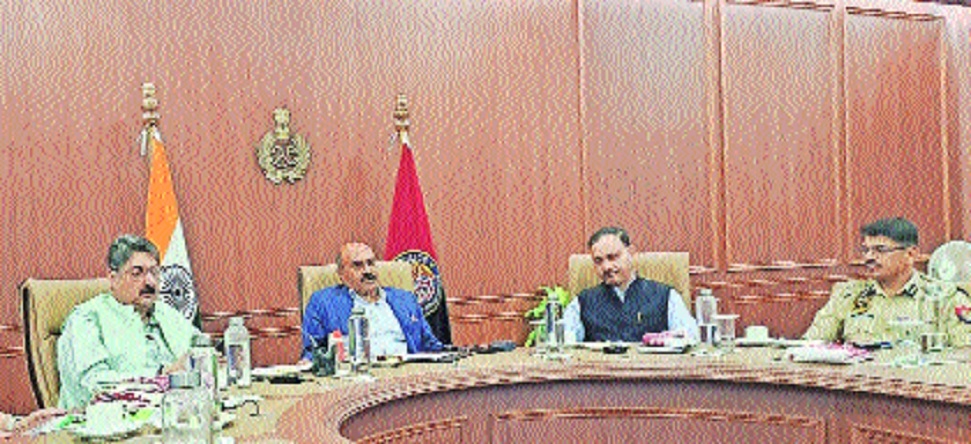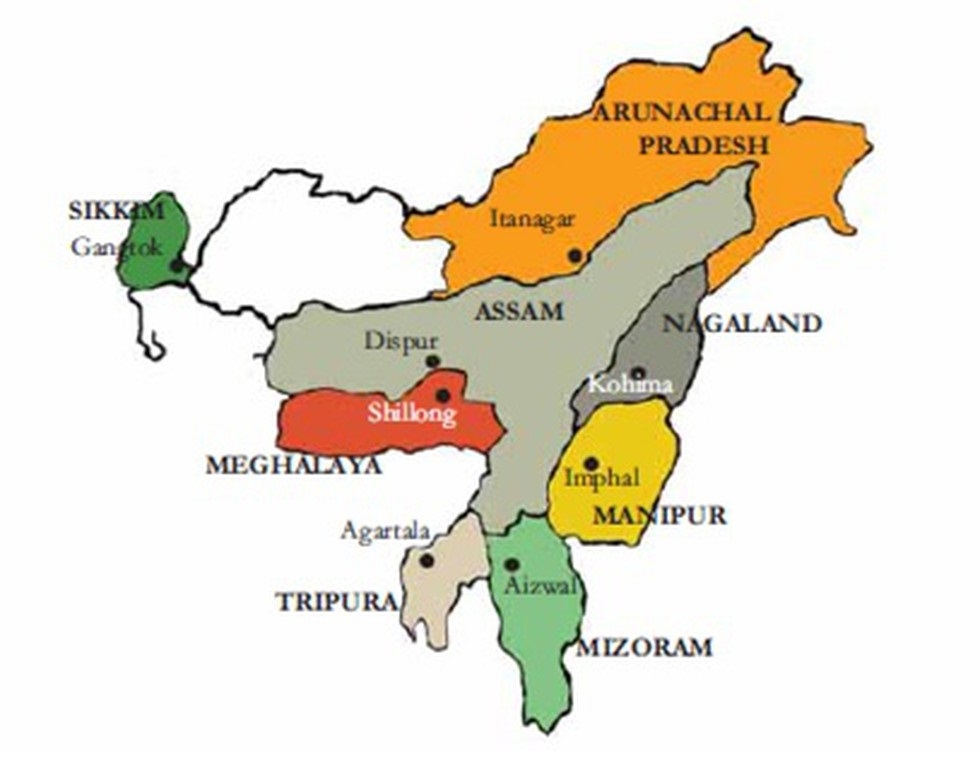Awesome Assam From insurgency to stability
| Date :12-Dec-2023 |

G P Singh, DGP, Assam; Harmeet Singh, Special DGP, Administration and HQ; Hiren Nath, Addl DG (Special branch); Dr Dhananjay Ghanawat, Asstt IGP (Administration), during an interaction with mediapersons from Maharashtra, at Assam Police Headquarters. (Pic by Kartik Lokhande)
By Kartik Lokhande :
GUWAHATI
FOCUS on N-E - Part-V
As the official data shows, Assam Police’s multi-pronged strategy has helped the State see a massive decline in insurgency.
ASSAM. The name brings before one’s eyes the picture of a State ravaged by insurgency, progress marred by instability, fear haunting the visitors, protests against alleged police brutality, demonstrations against Armed Forces Special Powers Act (AFSPA), etc.
However, if one visits Assam today, one finds that all these are fast becoming things of the past. In fact, Assam has come a long way since its identity as insurgency-ravaged State to a tourism-wise ‘Awesome Assam’ stage.

Assam Police, too, is fast evolving from an insurgency-oriented force to a citizen-centric service delivery system. After first travelling through the myriad landscape and getting first-hand experience of buzzing markets, developing highways, facilities for tourists, different flavours of Assam’s tea, bamboo art-works, cordiality and hospitality, if one visits the headquarters of Assam Police, one realises that Assam Police is indeed evolving very fast towards becoming a conventional police and leaving behind insurgency.
As the official data of Assam Police and ground situation show, Assam Police’s multi-pronged strategy has helped the State see a massive decline in insurgency. As is known,
Assam was ravaged by militancy for over three decades. The militant organisations had been getting support from neighbouring countries and had bases on foreign soil.
During the tumultuous period of over three decades, Assam saw emergence of more than 60 militant outfits belonging to different ethnic groups.
Some of these groups wanted secession from India and some others demanded separate statehood under the Constitution of India.
Obviously, the clashes took their toll on development and stability of Assam. In 30 years, Assam saw loss of life for 4,132 civilians and 921 security forces personnel. Of course, the same period also saw elimination of 3,209 militants, as per the official records.
“We adopted a unified command and four-pronged strategy to fight militancy. We can say that we have been successful in our mission,” said Gyanendra Pratap Singh, Director General of Police (DGP) of Assam, in an interaction. There have been large-scale surrender and ceasefire agreements between the Assam Government and the militants. So far, total 16,916 cadres have disbanded their outfits and joined the mainstream of society. Hiren Nath, Additional DGP (Special Branch), elaborated that the four-pronged strategy included constant counter-insurgency operations and area domination, peace overtures and negotiations, ceasefire/surrender and rehabilitation, and psychological operations and community policing. The efforts made under the unified command structure involving police and other agencies bore fruits. Under the counter-insurgency operations, total 9,637 sophisticated arms, 1,91,293 rounds of ammunition, and 3,281.715 kgs of explosives were recovered by the security forces from the extremists.
The surrendered militants of different outfits laid down 1,618 sophisticated arms, 25,892 rounds of ammunition, and 33.43 kgs of explosives. At present, according to official data with the Assam Police, five groups are under Suspension of Operations. Since 2020, three accords have been signed to restore peace in Assam. These include the Bodo Accord signed on January 27, 2020; the Karbi Accord signed on September 4, 2021; and the Adivasi Accord signed on September 15, 2022. Several militant groups have signed the Memorandum of Settlement (MoS) since 2003. Three groups signed the MoS till 2012 – Bodo Liberation Tigers in 2003, United Peoples Democratic Solidary in 2011, and Dima Halam Daogah-Dilip Nunisa Group and Dima Halam Daogah-Joel Group in 2012. However, since 2020, the process has gained momentum. In 2020, National Democratic Front of Bodoland signed the MoS. It was followed by Karbi groups viz. KLNLF, KPLT, PDCK, and UPLA signing the MoS in 2021. The next year, in 2022, Adivasi groups viz. APA, AANLA, ACMA, BCF, and STF signed the MoS. In 2023, Dimasa National Liberation Army has signed the memorandum. According to Dr Dhananjay Ghanwat, Assistant Inspector General of Police (Administration), some more groups under ceasefire and Suspension of Operations are awaiting signing of the MoS with the Government of India and the Government of Assam. These groups include ULFA (PT), KLO/KLA, KRA, UKDA and HPC (D), BRAU, and UDLF (BV). A few days ago, four cadres of ULFA-Independent also surrendered before the Assam Police. Even the AFSPA, said G P Singh, has been removed from all districts except four since March this year.
“This year, 2023, has been a remarkable year in past 32 years. For, no kidnapping or killing of a civilian by militants has taken place. We have been successful in weapons removal from criminals and militants,” he said proudly. He attributed credit to Himanta Biswa Sarma, Chief Minister of Assam, for ‘great leadership and quick decision-making’, with focus on action against organised crime, militancy, drug abuse, rhino poaching. Now, said Hiren Nath, the big task of rehabilitating the surrendered militants in mainstream is being implemented with renewed focus in the past two years. Under the Surrender and Rehabilitation Policy of Central Government and ‘Swawalamban’ scheme of State Government, so far, 8,756 former cadres of various outfits have been rehabilitated in the past two years. These include the highest 4,203 of NDFB, 1,926 of Karbi groups, 1,182 of Adivasi groups, and remaining of other outfits. “The younger ones are buying land and vehicles. Some have set up shops. Patanjali group will be providing 200 cows free to NLFB and UGPU militants. We have truly come a long way in restoring peace in Assam,” he added. People are a greater focus area of Assam Police now.
Harmeet Singh, Special DGP (Administration and Headquarters), said that there were several citizen-centric initiatives including DGP Grievance Cells up to district level, AI-based big data system, evidence management system, social media response etc. In short, Assam Police have begun a journey towards democratisation of police force through massive outreach. At the same time, Assam Police have developed personnel information management system, giving weekly offs to personnel, and has developed ‘zero tolerance’ towards corruption, moral turpitude, alcohol consumption on duty. And, Assam Police is walking the talk too. In one year, Assam Police have relieved 18 personnel under compulsory retirement scheme on charges of delinquency etc, dismissed 88 on charges of indulging in illegal activities and going against law. Besides, in a bid to strengthen police force, 586 have been given voluntary retirement scheme benefits on health and other grounds. But, the Assam Police’s war on drugs also is paving the way for saving younger generation from the drugs menace and securing their contribution in the State’s development and progress. (To be continued)